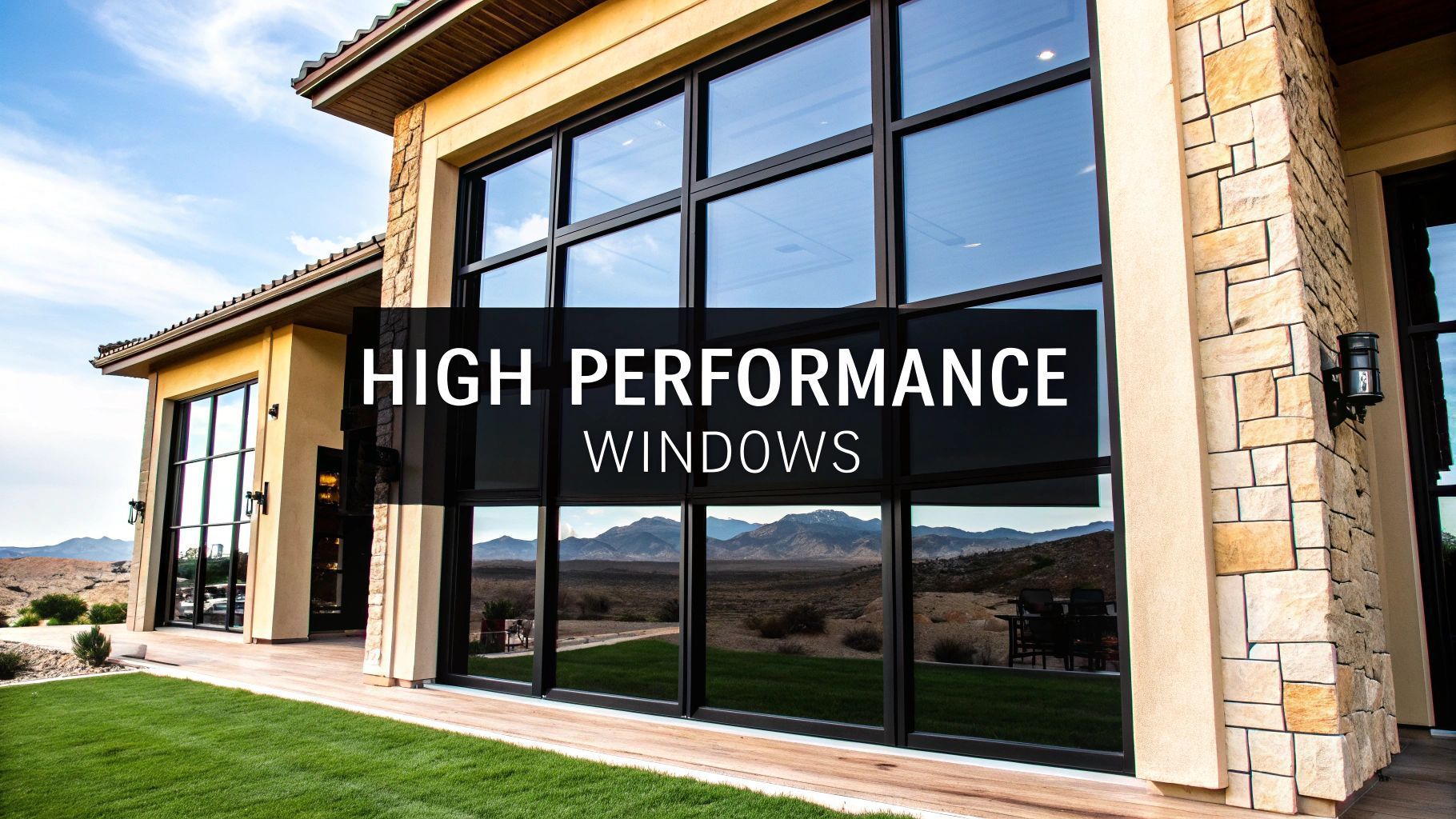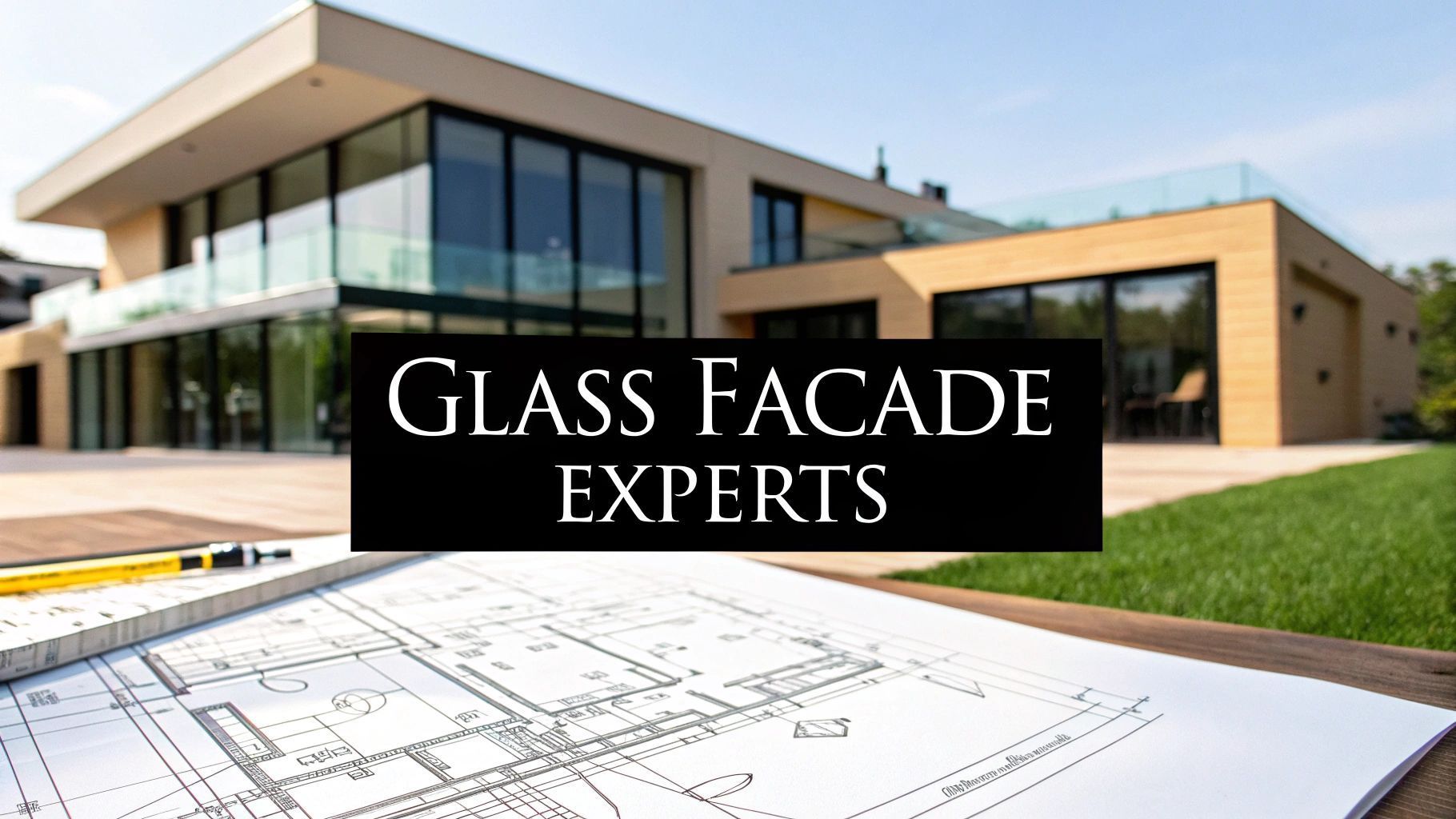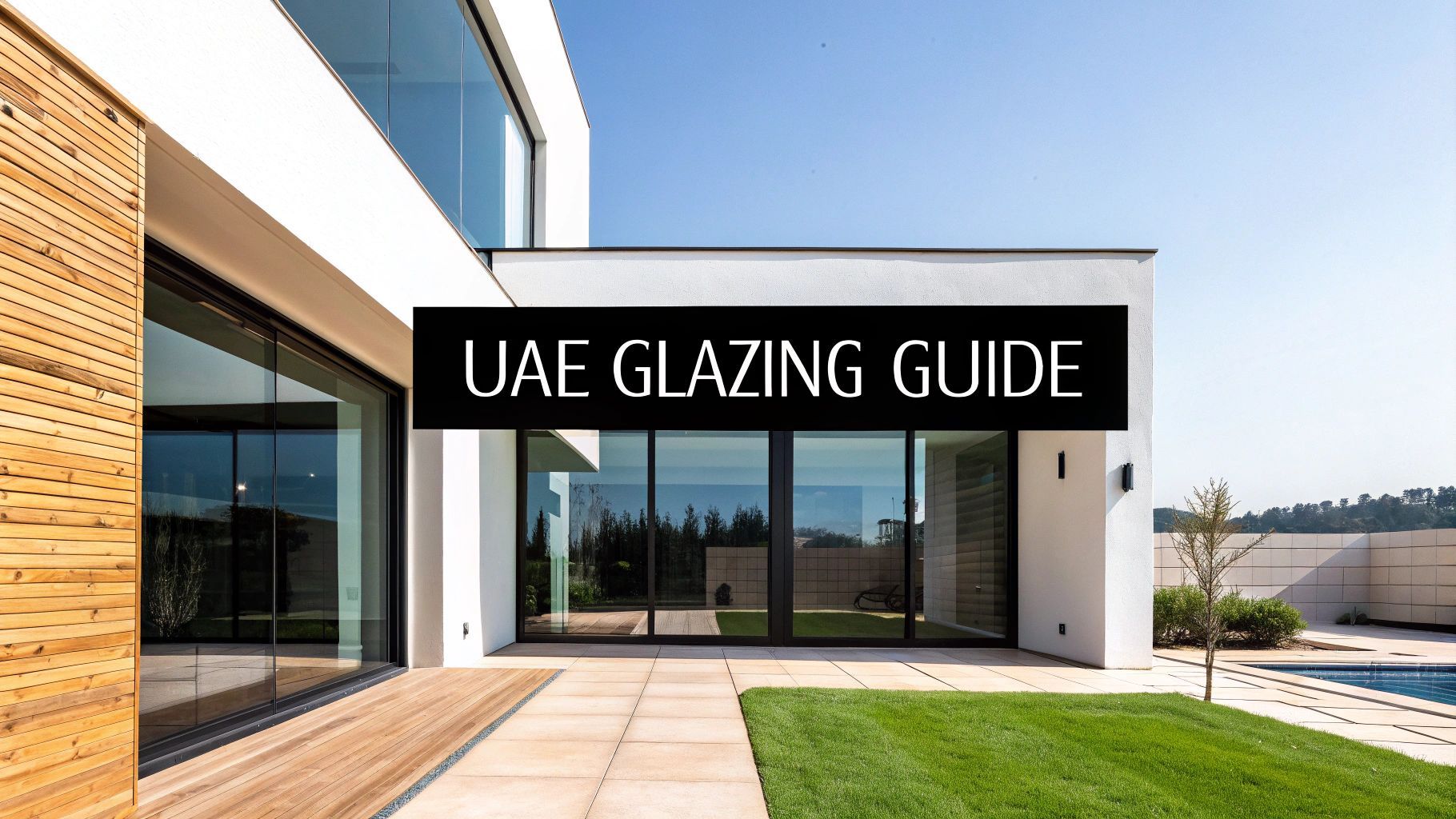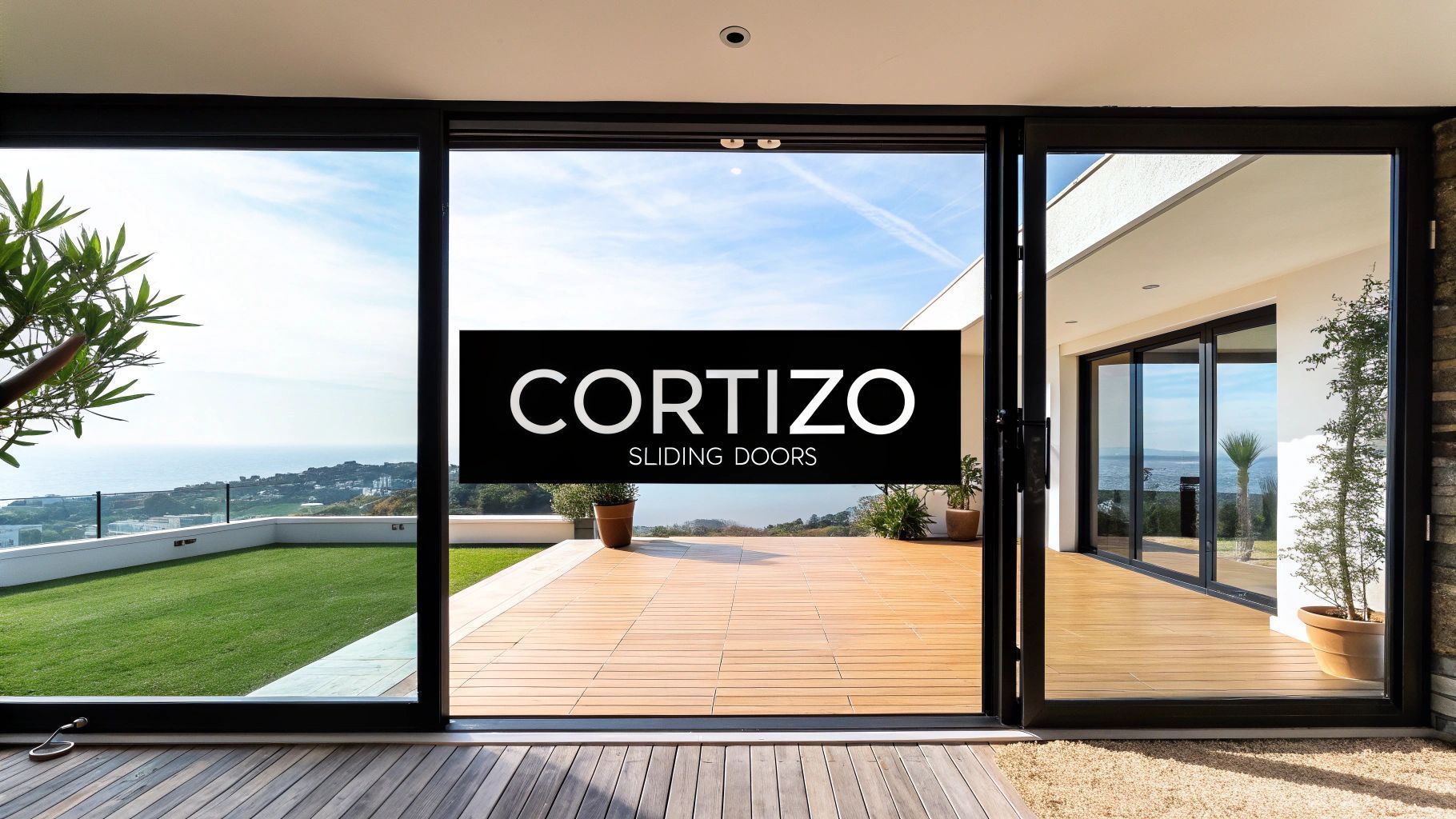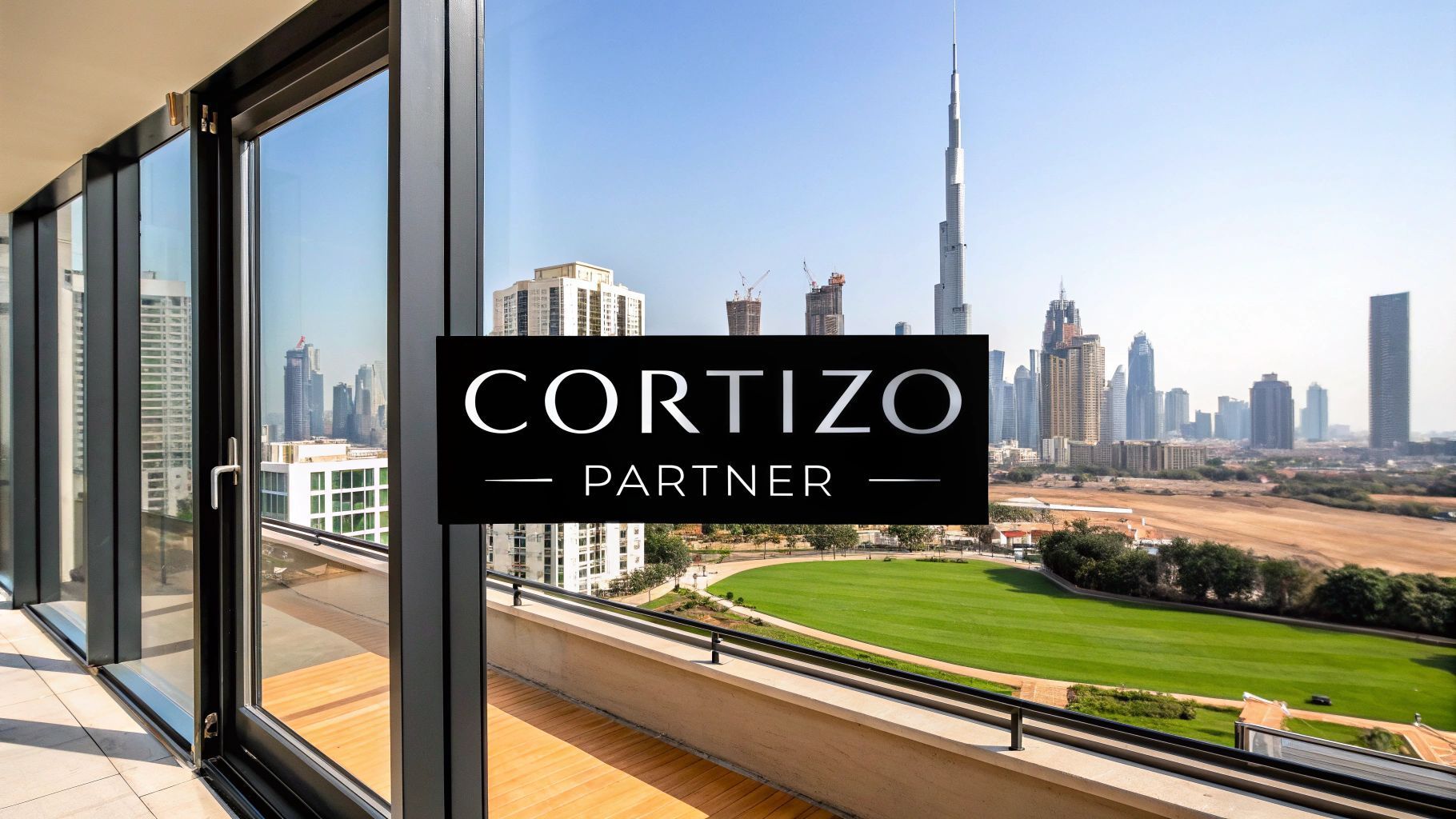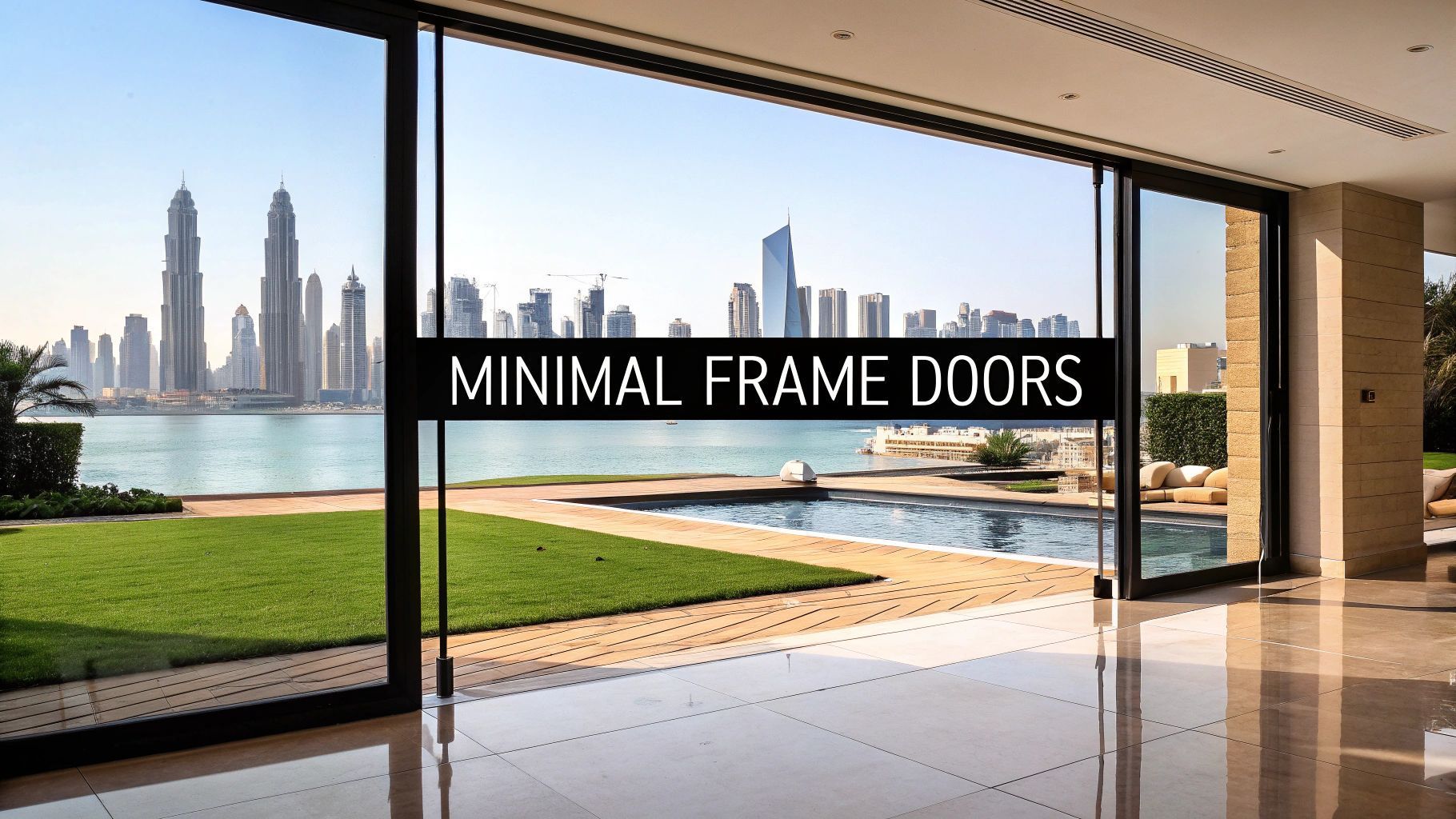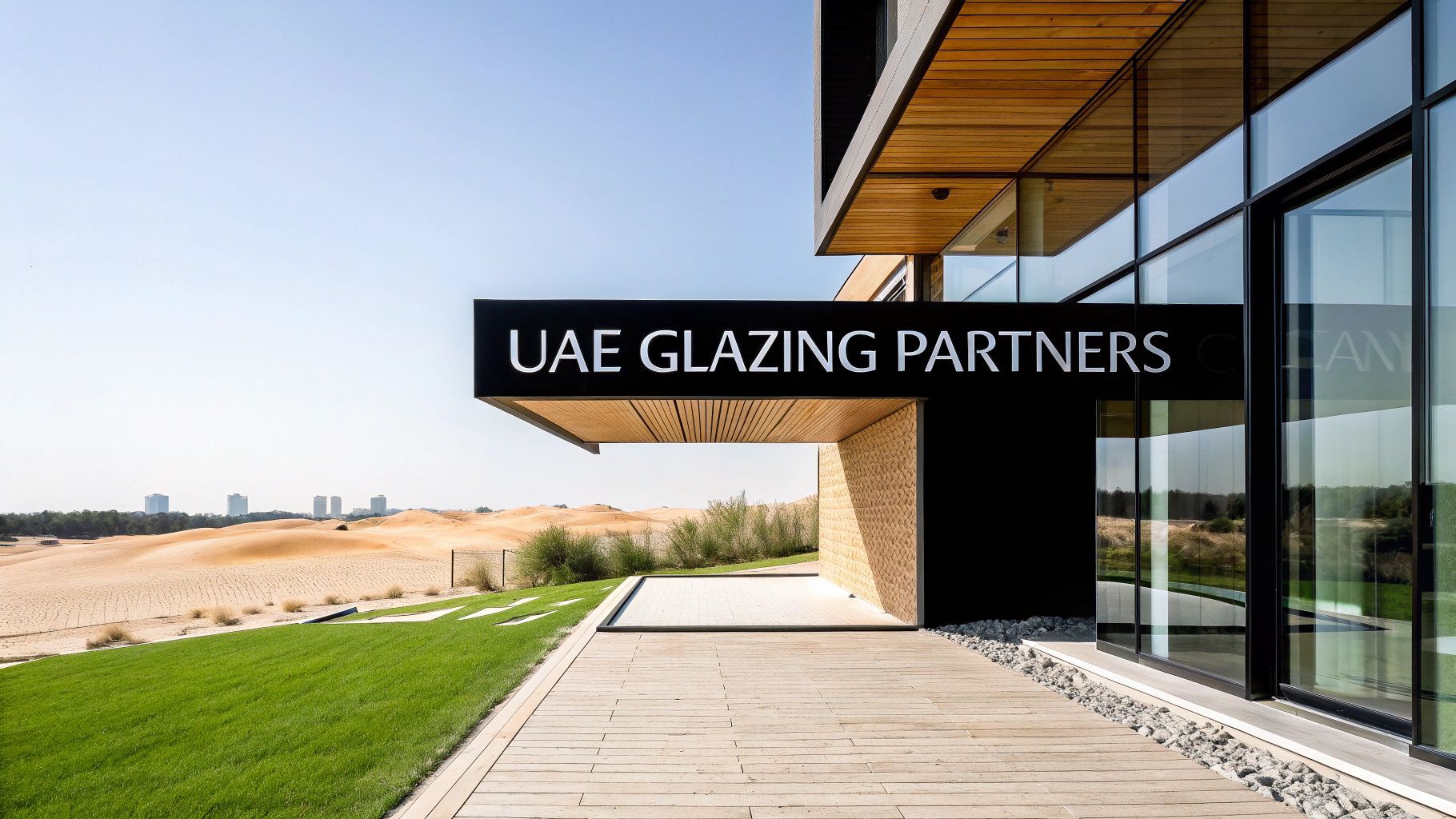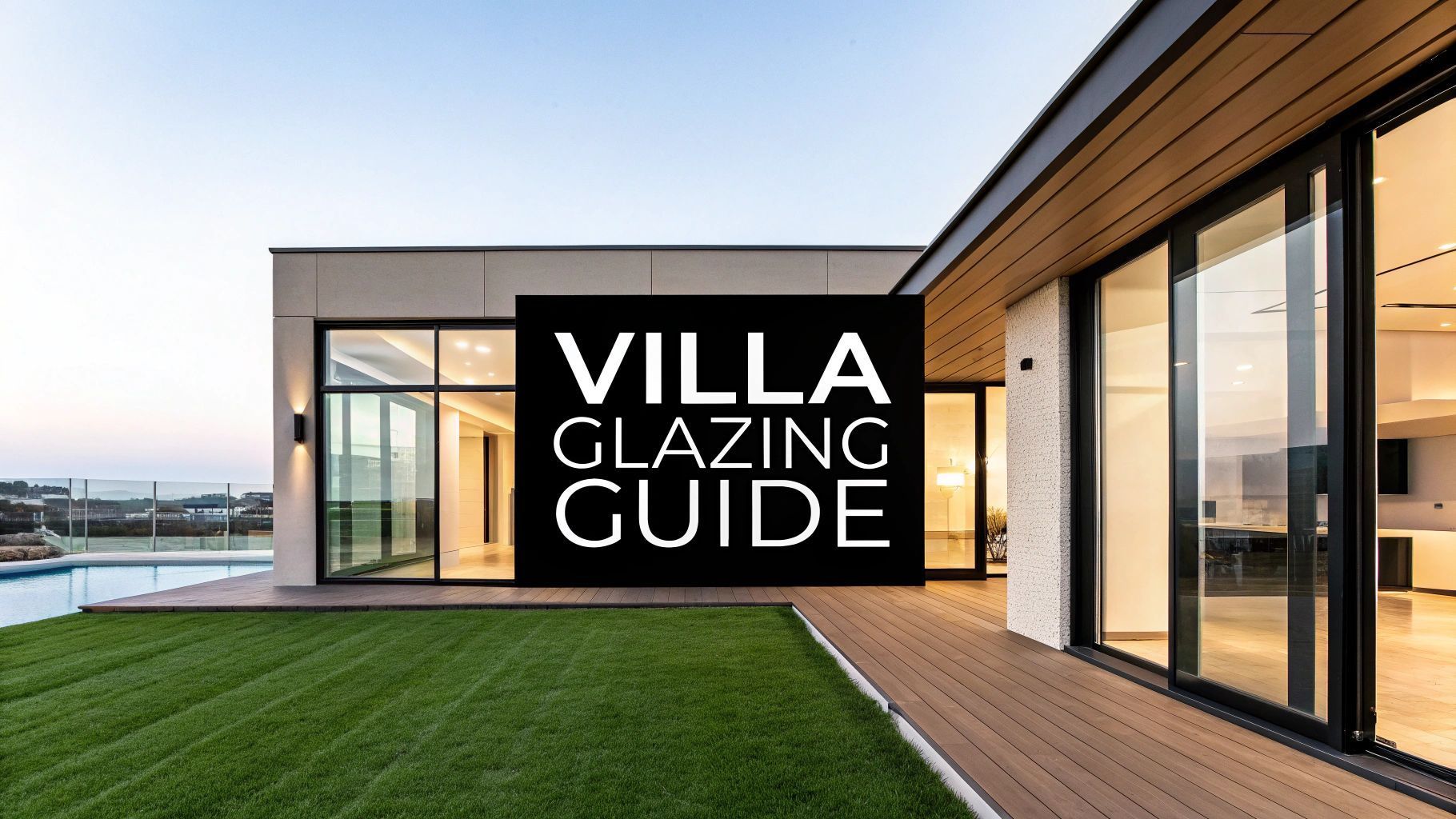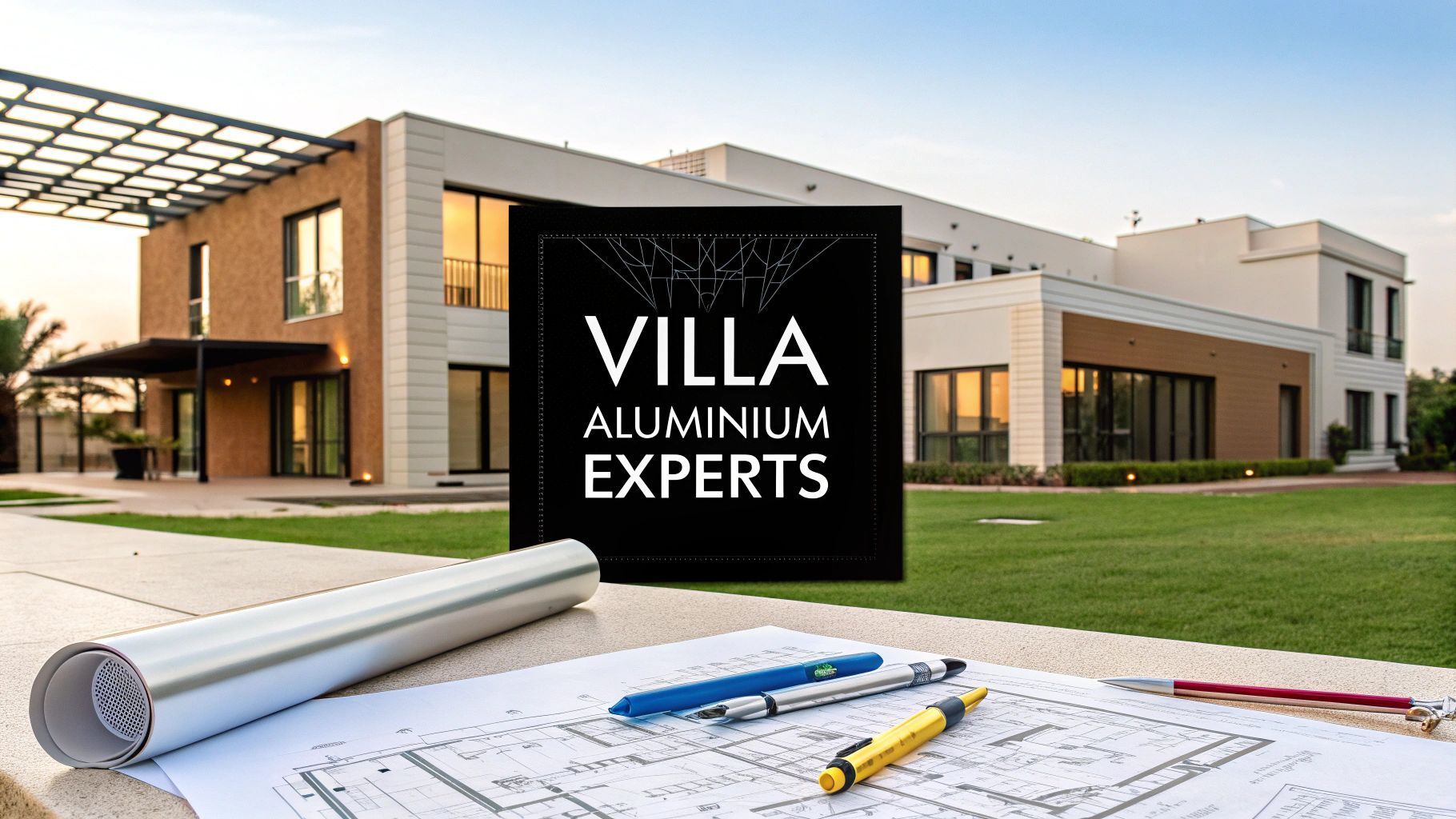A Guide to Stick System Curtain Walls in the UAE
A Guide to Stick System Curtain Walls in the UAE
When you hear "curtain wall," you might picture huge, pre-made glass panels being lifted into place by a crane. That's a unitised system, ideal for skyscrapers. But for custom homes and villas in the UAE, a more flexible, hands-on method often works best: the stick system curtain wall.
Think of it as bespoke tailoring for your home's exterior. Instead of arriving as a finished panel, individual components—the aluminium profiles (the "sticks"), glass panels, and high-performance seals—are delivered to your property. Technicians then assemble the entire facade piece by piece, right onto your villa’s structure.
This on-site assembly ensures a perfect fit, which is crucial for renovations in communities like Arabian Ranches or for unique new builds on Palm Jumeirah. It allows for a level of precision that factory-made panels can't match, creating a seamless and high-performance glass wall.
Understanding the Stick-Built Facade
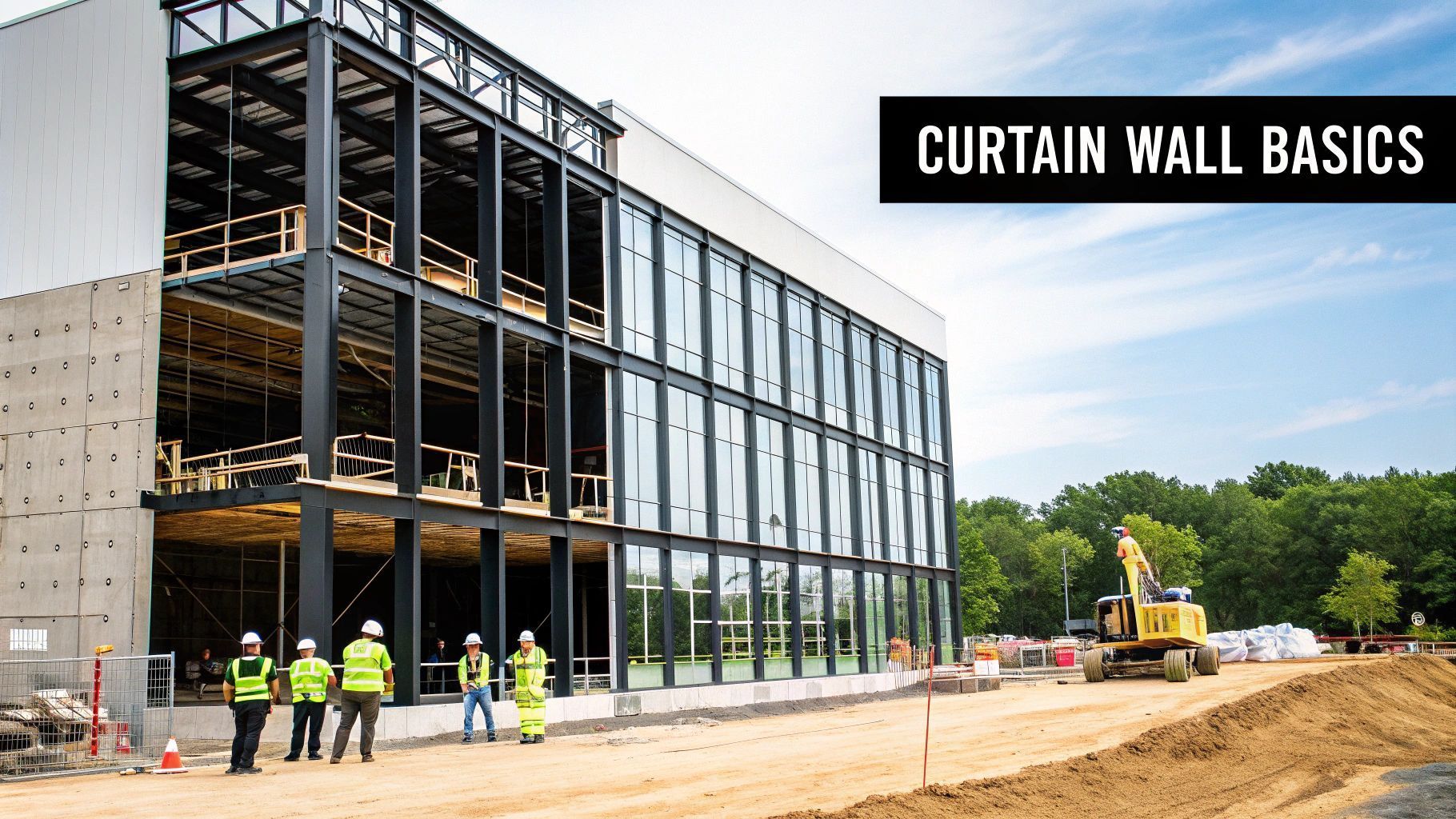
The stick system’s on-site assembly makes it incredibly adaptable. This method allows for an unmatched level of precision, ensuring every component fits the building's frame perfectly. It’s an approach that values craftsmanship, creating a truly custom glass facade that integrates flawlessly with the architectural vision.
Tailored for Unique UAE Homes
For homeowners and architects in Dubai and Abu Dhabi, this tailored approach is a game-changer, especially for projects where standard solutions just won't work.
- Custom Renovations: Upgrading a villa in a community like Arabian Ranches? A stick system can be precisely fitted to the existing structure, easily accommodating any older building's unique quirks.
- Unique New Builds: Designing a one-of-a-kind home on Palm Jumeirah? This system lets you create complex angles or dramatic, oversized glass expanses without being limited by factory constraints.
- Seamless Integration: It allows for the smooth incorporation of other elements, like high-performance windows from Cortizo's Cor 70 range or expansive Vetro Slide sliding doors, creating a cohesive facade.
This method is perfectly suited for the low to mid-rise residential buildings that define the UAE's villa communities. It gives architects the control they need to solve unique design challenges and bring stunning, light-filled visions to life.
Stick System at a Glance
| Characteristic | Description | Why It Matters for UAE Villas |
|---|---|---|
| On-Site Assembly | Components are installed piece by piece directly on the building. | Perfect for renovations in communities like Arabian Ranches with non-standard dimensions. |
| Design Flexibility | Allows for complex shapes, curves, and seamless integration of windows/doors. | Architects can design unique villa facades on Palm Jumeirah without being limited by pre-fab sizes. |
| Cost-Effective | Generally more economical for smaller-scale or complex low-rise projects. | An ideal balance of performance and budget for luxury villa construction and upgrades. |
| Local Craftsmanship | Relies on skilled on-site labour for a precise, high-quality installation. | Ensures a perfect seal against the UAE's heat, dust, and humidity—critical for comfort and energy savings. |
The on-site craftsmanship is what makes the stick system so resilient and well-suited to the UAE's specific environmental challenges like heat and dust.
A Popular Global Choice
The stick system's blend of flexibility and cost-effectiveness has made it a global contender. Stick systems account for about 30% of the worldwide curtain wall market, valued at over USD 44.2 billion. The Middle East & Africa is a key driver of this demand.
The hands-on installation process ensures every joint and seal is perfectly executed. This provides the robust weatherproofing needed to handle the region's intense heat, humidity, and seasonal dust storms, keeping your home comfortable and energy-efficient.
How a Stick System Is Installed On-Site
The journey from a bare concrete frame to a stunning glass facade is a meticulous process. A stick system curtain wall is built piece by piece right on your property, guaranteeing a perfect, customised fit for your villa. It’s where construction becomes craftsmanship.
Imagine a new villa taking shape in Dubai Hills Estate. The process begins with the foundational grid. The first step is precisely fixing the vertical aluminium profiles, known as mullions, to the villa's concrete slabs. This creates the primary structural backbone of the facade.
Once the vertical framework is secure, the horizontal profiles, or transoms, are fitted between them. Technicians work methodically to form a rigid, grid-like structure. This grid defines the final look of the curtain wall, setting the size and placement of every glass panel.
The Step-by-Step Assembly Process
This visual shows the fundamental sequence of assembling a stick system curtain wall, from the initial frame to the final glazing.
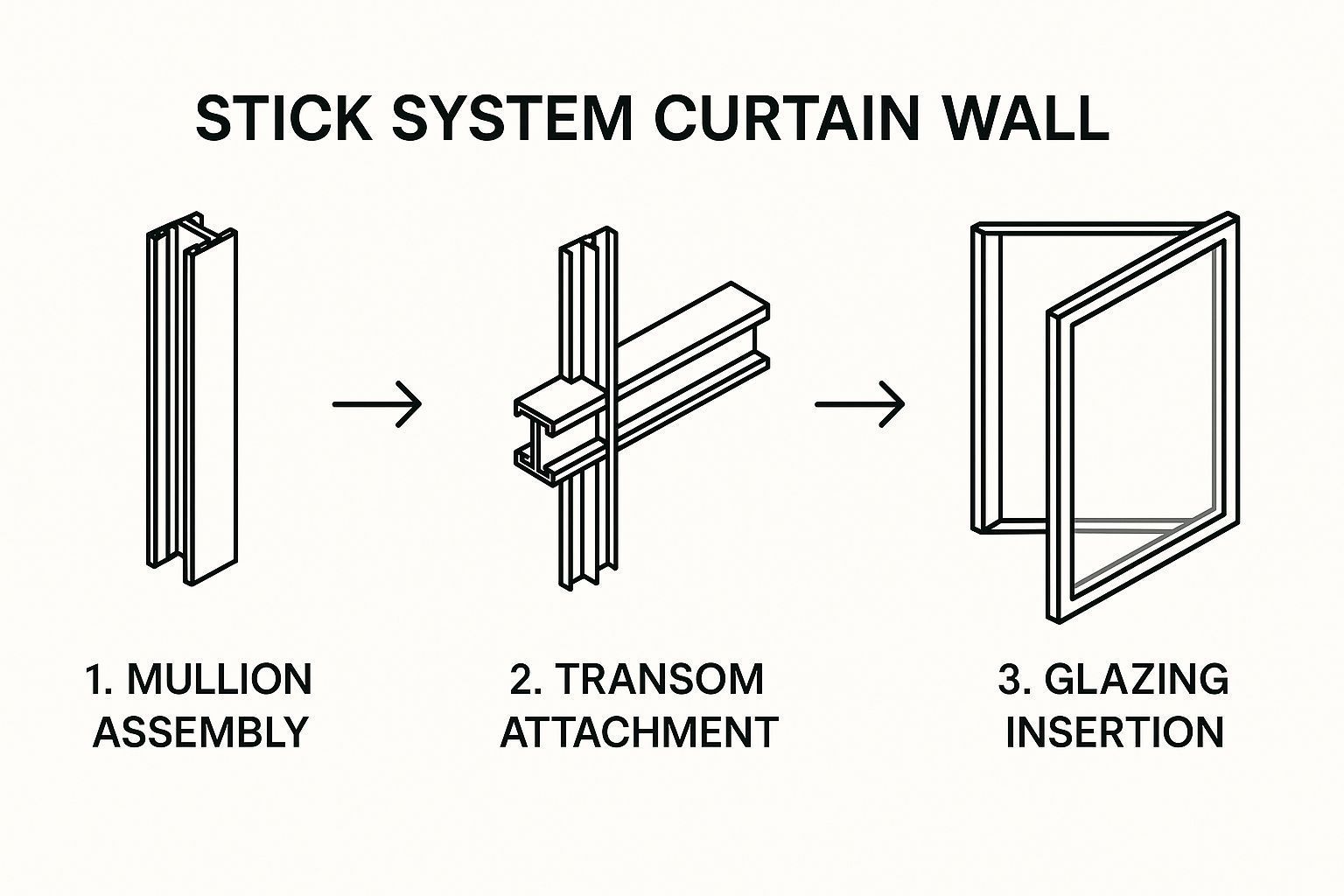
The image highlights how each stage builds upon the last, creating a structurally sound framework before any glass is even brought to the site. This sequential assembly is the secret to the system's precision and adaptability.
With the aluminium grid complete, the next phase is glazing. High-performance, double-glazed glass units are carefully lifted and set into each opening. This step demands immense care to ensure each heavy panel sits perfectly. The choice of glass is vital for thermal performance in the UAE climate.
Sealing the Envelope for Maximum Protection
The final and most critical stage is sealing the system. This is where the curtain wall truly proves its worth against the UAE’s harsh environment of heat, dust, and humidity.
- Pressure Plates: After the glass is set, outer aluminium pressure plates are screwed onto the mullions and transoms, holding the glass firmly in place.
- Gaskets: High-grade rubber gaskets are installed between the glass and the aluminium frame, creating an airtight and watertight barrier.
- Cover Caps: Finally, decorative cover caps are snapped onto the exterior. This provides a clean, finished look while protecting the components from the elements.
This detailed, multi-layered sealing process is what makes a stick system so effective at keeping a villa cool, quiet, and clean.
For a homeowner in Arabian Ranches, this means that during a shamal (sandstorm), the fine dust stays outside. The meticulous on-site sealing creates a robust barrier, preserving indoor air quality and stopping drafts that hurt AC efficiency.
This on-site assembly ensures every joint is perfectly sealed, delivering superior insulation against heat, noise, and the pervasive dust of the region.
Key Advantages for UAE Villa Projects
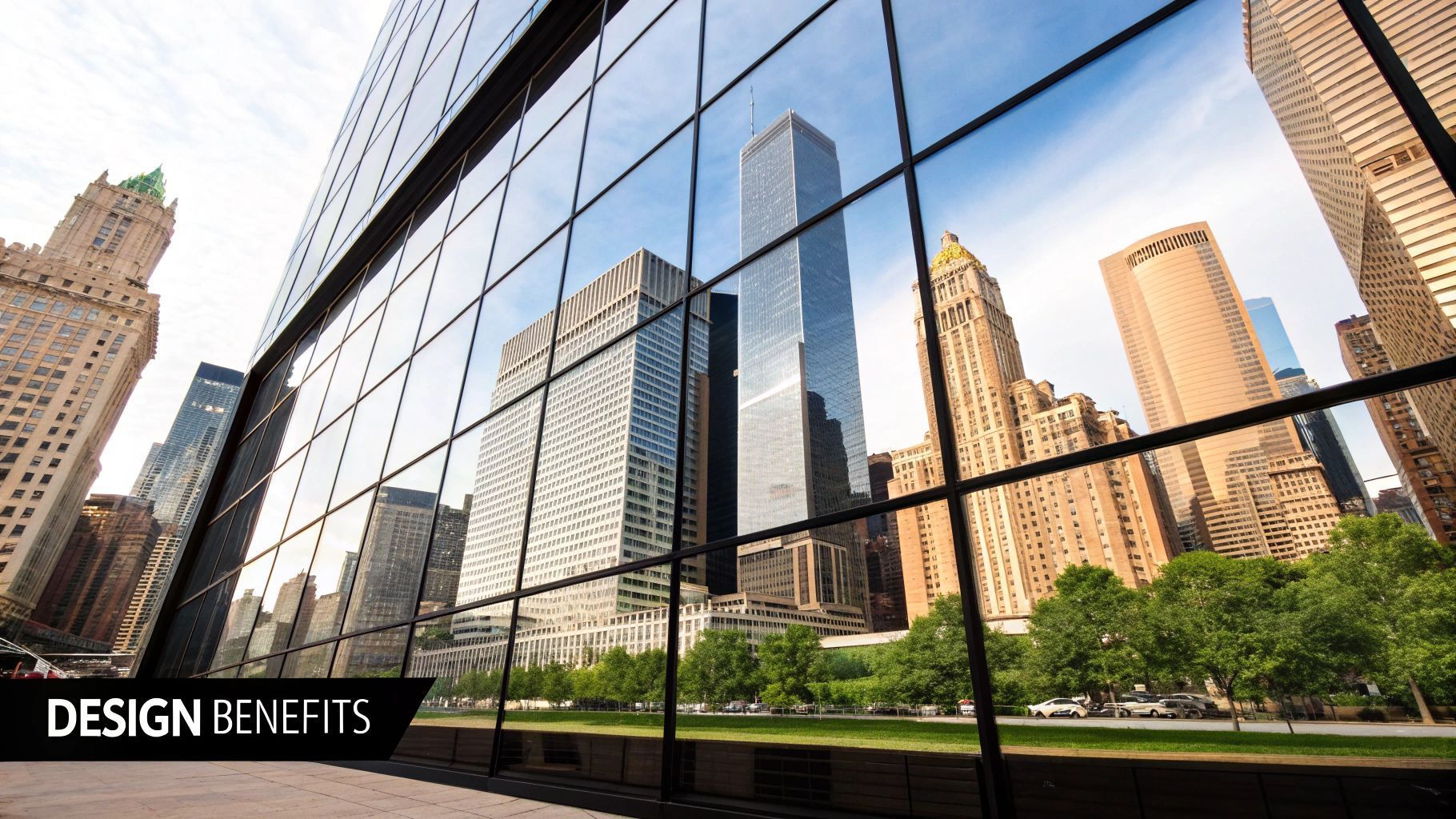
For villa projects across the UAE, a stick system curtain wall offers more than just stunning looks. It’s a practical solution to the region's biggest environmental challenges: extreme heat, dust, noise, and humidity. Its on-site assembly provides significant advantages in boosting comfort and cutting running costs.
The demand for these advanced facades is growing fast. The Middle East & Africa glass curtain wall market was valued at USD 0.25 billion and is expected to hit USD 0.44 billion by 2032. This boom is fuelled by GCC construction projects where a high-performance building envelope is a necessity. You can get more insights from Stellar Market Research.
Superior Thermal Performance for Lower Cooling Costs
In the UAE, keeping a villa cool is a top priority. A stick system excels here because it allows the integration of advanced components designed to block heat. A key feature is thermally broken aluminium profiles.
A thermal break is a strip of non-conductive material inserted into the aluminium frame. It acts as a powerful barrier, stopping the intense outdoor heat from travelling through the metal and into your home. It’s a simple concept with a huge impact on energy efficiency.
Combine these frames with high-performance double glazing, and the results are dramatic. For example, a system like Cortizo's Cor 70 uses a robust thermal break to slash heat gain. This means your AC works less, leading to lower DEWA bills and a more comfortable home.
An Impenetrable Barrier Against Dust and Noise
The careful, step-by-step sealing process of a stick system creates a formidable shield against the elements. For anyone living in Dubai or Abu Dhabi, this brings two huge benefits.
- Dust and Sand Protection: During a shamal, fine sand can get everywhere. The multi-layered sealing of a stick system closes off tiny gaps, protecting your indoor air quality and keeping your home clean.
- Acoustic Insulation: If your villa is near a busy road, outside noise can be a problem. The same airtight seals that block dust also provide fantastic sound dampening, creating a peaceful home.
This level of sealing is difficult to achieve with other methods, making the stick system a great choice for a calm, healthy indoor environment.
Unmatched Design Flexibility for Bespoke Homes
Perhaps the biggest draw of a stick system is the creative freedom it provides. Because the entire structure is built on-site, architects aren't limited by standard factory panel sizes. This is perfect for the bespoke luxury villas seen across the UAE.
Imagine a modern villa on Saadiyat Island, Abu Dhabi, with a dramatic, double-height glass wall. A stick system makes this possible. The profiles can be cut and assembled to any dimension, easily accommodating unconventional angles, curves, or oversized panes of glass.
This flexibility is also a game-changer for renovations. For a homeowner in Jumeirah wanting to replace a solid wall with an expansive glass facade, the stick system can be tailored to fit the existing structure perfectly, transforming the home's connection to its garden and views.
Choosing the Right Facade System for Your Villa
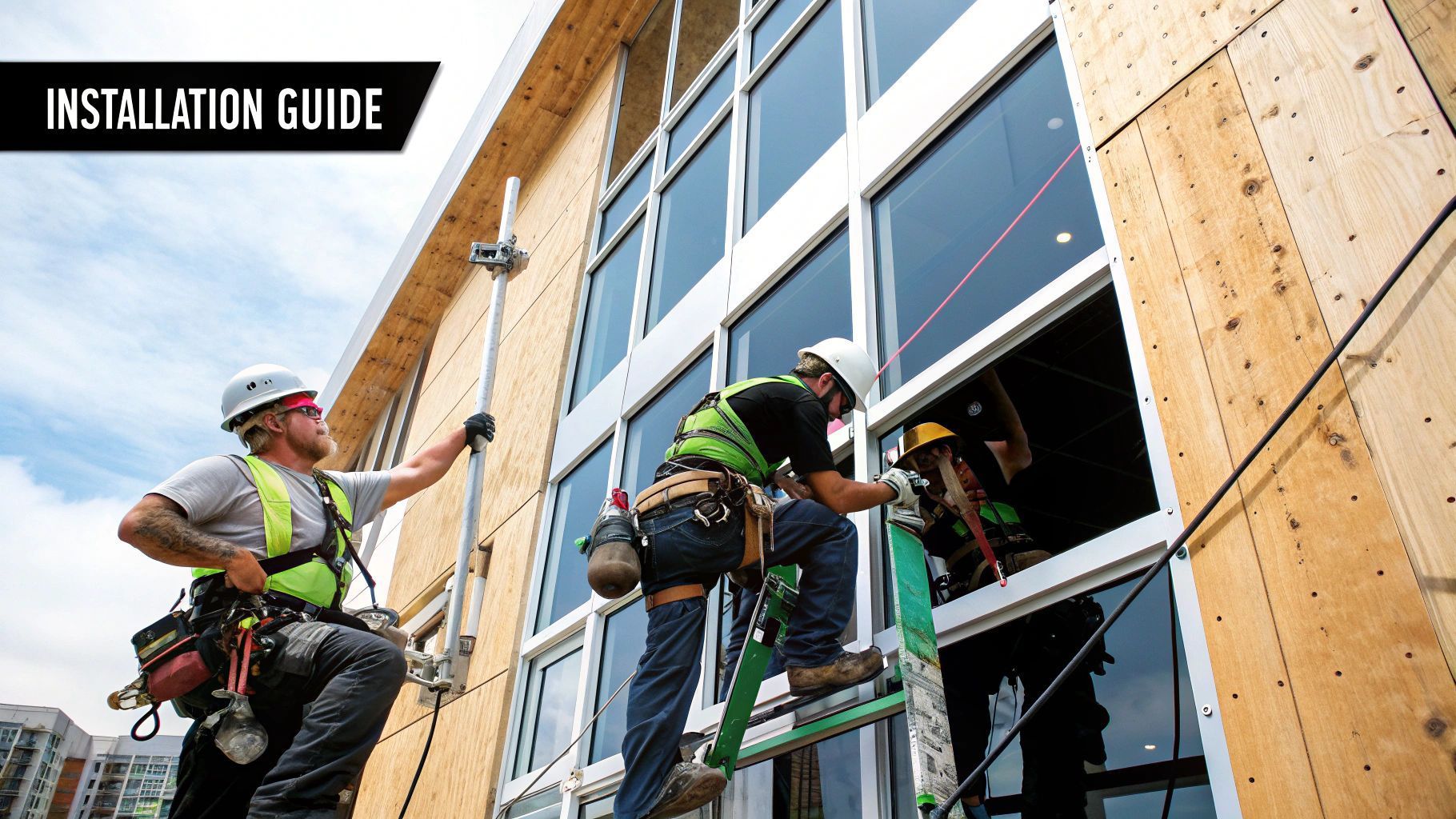
Picking the facade for your villa is a huge decision. It defines your home's look, comfort, and energy performance. In the world of curtain walling, the two main options are the stick system and the unitised system.
They may look similar when finished, but their assembly and best use cases are very different—especially for residential projects in the UAE.
It's not about which system is "better," but which is right for your project's size, design, and budget. For the bespoke nature of building or renovating a villa, the stick system curtain wall is almost always the more practical and flexible choice.
Stick Systems for Custom Homes and Renovations
Think of the stick system as the craftsman's choice. It's assembled on-site, piece by piece, making it perfect for projects that need a high level of customisation. For renovating a villa in Arabian Ranches or building a unique home on Palm Jumeirah, this adaptability is invaluable.
This on-site approach is a lifesaver when working with existing buildings where walls may not be perfectly straight. The stick system lets installers fit the frame to the building's true conditions, guaranteeing a perfect seal that a pre-made panel can't match. To understand how it all comes together, it helps to know the different parts of your home's exterior.
Unitised Systems for Large-Scale Towers
The unitised system is all about speed and repetition on a massive scale. Huge, factory-made panels—complete with glass and seals—are craned into place on-site. This is incredibly efficient for skyscrapers in Downtown Dubai, where every floor plan is identical.
For a single villa, however, the large upfront costs for factory setup and logistics make it impractical. Its lack of on-site flexibility also makes it a poor choice for the unique designs and renovation jobs common in the residential sector.
Comparing Stick vs Unitised Systems for Residential Use
Here’s a straightforward comparison to help you decide what’s right for your villa.
| Factor | Stick System | Unitised System | Best For |
|---|---|---|---|
| Design Flexibility | Extremely high; ideal for custom shapes, curves, and unique villa designs. | Limited; best for repetitive, uniform facades on high-rises. | Unique architectural villas and complex renovations. |
| Installation Time | Slower on-site, as it is built piece by piece with high attention to detail. | Faster on-site installation, but has a long factory lead time. | Large commercial towers with tight construction schedules. |
| Quality Control | Highly dependent on the skill of the on-site installation team. | High, as panels are fabricated in a controlled factory setting. | Projects where factory precision outweighs design freedom. |
| Cost-Effectiveness | More economical for smaller, unique, or complex low-rise projects like villas. | Cost-effective only for very large, repetitive facade areas. | Individual villas, low-rise residential buildings, and upgrades. |
For the vast majority of villa projects in the UAE, the stick system curtain wall delivers the best mix of performance, aesthetic freedom, and value. The profile size also matters, which you can explore in our guide comparing 50mm vs. 35mm curtain wall systems.
Design Considerations for the UAE Climate
A stick system curtain wall must be specified correctly to perform in the UAE. A stunning glass facade that can’t handle the intense summer heat or a sandstorm is a failed investment. Success means choosing the right components to create a resilient and energy-efficient building envelope.
This demand for high-performance facades is fuelling market growth. The global stick system curtain wall market was valued at USD 6.1 billion and could climb to USD 9.1 billion by 2032. The Middle East is a key part of this trend. You can see more on this at dataintelo.com.
To ensure your villa’s facade is ready for our climate, focus on three critical areas: the glass, the frame, and the seals.
Glazing Selection for Solar Control
The most important decision for any curtain wall in the UAE is the glass. Standard single-pane glass is not an option—it lets solar heat pour into your home, forcing your AC to work overtime.
The minimum standard is a high-performance double-glazed unit (DGU). This is a sealed unit with two panes of glass separated by an air gap. The real magic comes from an invisible Low-E (low-emissivity) coating on the glass. This microscopic metallic film reflects heat while allowing visible light to pass through.
Think of a Low-E coating as a smart gatekeeper. It welcomes the natural light that brightens your villa in Arabian Ranches but blocks the punishing solar heat, keeping your interiors cool and your DEWA bills down.
This technology is essential for comfortable living in the UAE. For a deeper dive, check our guide on what Low-E glass is and why it matters in Dubai.
Frame and Finish to Combat the Elements
The aluminium frame provides the structural backbone, but standard aluminium is a great conductor of heat. That’s why specifying thermally broken aluminium profiles is essential. Systems from brands like Cortizo or Vetromax integrate a thermal barrier that stops heat in its tracks.
The exterior finish is just as important. The combination of high humidity, coastal salt, and wind-blown sand can damage poor-quality finishes. A durable powder-coated finish is the best defence. It creates a tough layer that resists corrosion, chipping, and fading from intense UV exposure.
Sealing and Gaskets for Airtight Performance
Finally, the unsung heroes of a high-performance curtain wall are its gaskets. These flexible rubber seals are fitted between the glass and the aluminium frame. For the UAE, high-grade EPDM gaskets are the industry standard.
EPDM is exceptionally durable, standing up to UV radiation and extreme temperatures without cracking. A properly installed stick system uses a multi-layered gasket seal. This creates an airtight envelope that is incredibly effective at blocking dust, preventing humid air from entering, and providing excellent acoustic insulation.
Your Questions, Answered
When planning a villa project in the UAE, you’re bound to have practical questions about how a stick system curtain wall will perform.
Here are answers to common queries about cost, climate, and renovations.
How Much Does a Stick System Cost for a Villa in Dubai?
The final price of a stick system curtain wall depends on several factors. The complexity of the design, total area, the brand of the aluminium system (like Cortizo or Vetromax), and the glass specifications are all major cost drivers.
However, for a custom home, a stick system is almost always more budget-friendly than a unitised system. You avoid the high factory setup and transport costs of pre-built panels. For an accurate price, a detailed quote based on your architect’s drawings is necessary.
Is a Stick System Effective Against Sandstorms?
Yes, a professionally installed stick system offers excellent protection against sand and dust. Its secret is the meticulous on-site sealing process, which is ideal for combating the fine particles in a UAE shamal.
During installation, multiple layers of high-performance EPDM gaskets are fitted between the glass and the aluminium frame. This creates an incredibly effective, airtight barrier that stops fine dust, maintaining clean indoor air and protecting your home's interior.
Can a Stick System Replace an Existing Villa Wall?
Definitely. A stick system is an ideal solution for villa renovations and upgrades. Its biggest advantage is that it's assembled on-site, allowing installers to make precise adjustments to fit the existing structure perfectly—even with the slight irregularities found in older buildings.
This makes it the go-to choice for replacing a living room wall with a floor-to-ceiling glass feature in communities like Arabian Ranches or Jumeirah. The system can be tailored to the exact dimensions on-site, ensuring a seamless integration that transforms the space.
If you're planning a renovation or villa upgrade in the UAE, Swift Rooms can help you specify the best window and door system for your project. Contact us today for a quote or consultation.

